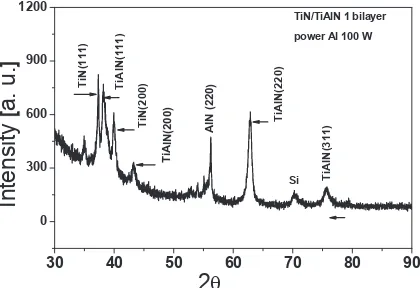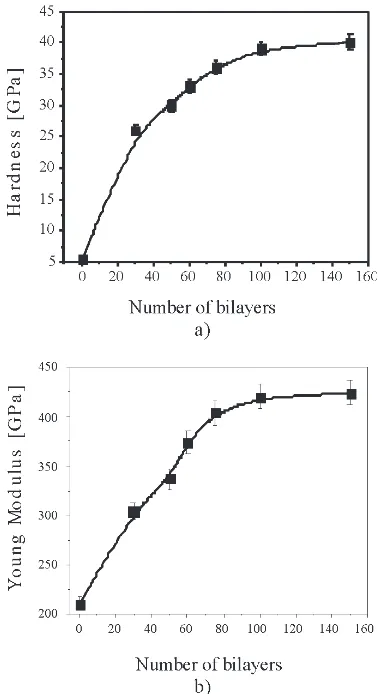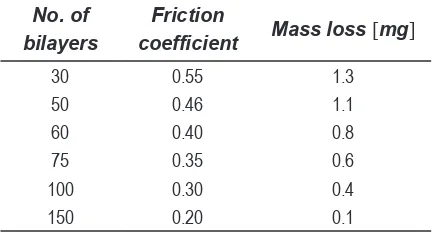36
Mechanical and tribological properties
enhancement of heat treated AISI 4340 steel by
using a TiN/TiAlN multilayer coating system
Mejoramiento de las propiedades mecánicas
y tribológicas del acero AISI 4340 tratado
térmicamente, utilizando un recubrimiento de
multicapas de TiN/TiAlN
Gilberto Bejarano1*, Julio Caicedo2, Juan Muñoz Saldaña3
1Corrosion and Protection Group, Engineering and Composite Materials
Science Group, Universidad de Antioquia, calle 67 N.° 53-108. Medellín-Colombia.
2CDT ASTIN, SENA, GIDEM Group, Calle 52 No. 2 Bis 15 A.A. 8053 Cali
Colombia
3Center for advanced Research CINVESTAV, Fraccionamiento Real de
Juriquilla, C.P. 76230, Querétaro, México.
(Recibido el 31 de agosto de 2007. Aceptado el 29 de Enero de 2008)
Abstract
TiN/TiAlN (titanium nitride/titanium aluminum nitride) multilayer were deposited by d.c. reactive magnetron sputtering using titanium and aluminum targets with 10 cm in diameter and 99.9% purity in an argon/nitrogen (Ar/ N) atmosphere, applying a substrate temperature of 300°C and a pressure of 7x10-3 mbar. Silicon (100) and heat treated AISI 4340 steel samples with a
hardness of 54 Rockwell C (HRC, approximately 5.4 GPa) were utilized as substrate. TiN/TiAlN coatings with 70% aluminum and 4 µm total thickness were investigated as function of multilayer number and their mechanical and tribological properties compared to the uncoated steel samples. The crystalline structure of the coated samples was analyzed through X-ray diffractometry and its morphology and topography using scanning electron microscopy (SEM) and atomic force microscopy (AFM). Hardness was determined by means of nanoindentation, while wear resistance was characterized through pin on disc measurements. A hardness and Young Modulus increment from
62% and 70% respectively, were obtained for 150 multilayer of TiN/TiAlN related to 30 bilayers and from 740% and 202% respectively, compared with the uncoated AISI 4340 steel samples. Finally the friction coefficient was reduced from 0.55 down to 0.20 and the roughness from 63 nm to 3.2 nm for the steel samples coated with 150 bilayers of TiN/TiAlN, what conduced to a greater wear resistance of the coating system.
--- Keywords: Magnetron sputtering, multilayer system, hard coatings, TiN/TiAlN coatings
Resumen
Multicapas de TiN/TiAlN (nitruro de titanio/nitruro de titanio aluminio) se depositaron por la técnica de la pulverización catódica d.c. reactiva utilizando blancos de titanio y de aluminio de 10 cm de diámetro, con una pureza de 99,9%, en una atmósfera de argón y nitrógeno (Ar/N), aplicando una tem-peratura de 300°C y una presión de 7x10-3 mbar al sustrato. Como sustratos
se utilizaron silicio (100) y acero AISI 4340 tratado térmicamente con una dureza de 54 Rockwell C (HRC, aproximadamente 5,4 GPa). Recubrimientos de TiN/TiAlN con un contenido de Al de 70% y un espesor total de 4 µm se investigaron en función del número de multicapas y sus propiedades mecá-nicas y tribológicas se compararon con las de las muestras de acero sin recu-brir. La estructura cristalina de las muestras recubiertas se analizó mediante difracción de rayos X, la morfología y topografía con microscopia electrónica de barrido (SEM) y microscopia de fuerza atómica (AFM). La dureza se de-terminó mediante nanoindentación, mientras que la resistencia al desgaste se caracterizó a través de mediciones de pin on disc. Para las 150 multicapas de TiN/TiAlN se obtuvo un incremento en la dureza y en el módulo de Young de 62% y 70% respectivamente, en relación a las 30 bicapas iniciales, y de 740% y 202% respectivamente, comparado con el acero AISI 4340 sin recubrir. Finalmente, el coeficiente de fricción se redujo de 0,55 a 0,20 y la rugosidad de 60 nm a 3,2 nm para las probetas de acero recubiertas con 150 bicapas de TiN/TiAlN, lo cual condujo a una mayor resistencia al desgaste del sistema de recubrimiento.
38
Introduction
AISI 4340 steel have been used for a great number of applications in the machine construction industry with hardness between 28 and 38 Rockwell C (HRC). This kind of low alloyed steel is very cheap, compared with the expensive high alloyed tools steel, and it has an appropriated hardness combined with a very high toughness and tensile strength. For cutting tools applications this low alloyed steel must be austenized, quenched and tempered by a time – temperature cycle so that, it reaches hardness greater than 52 HRC and an acceptable toughness. However its hardness is not high enough and its chemical composition is inappropriate to enable a rentable and economical cutting process [1]. To achieve a higher hardness and wear resistance, this type of steel can bee coated with hard films deposited through different physical vapour and plasma assisted deposition techniques, so that a cutting process more rentable can be carried out. Hard coatings, normally binary materials based on nitrogen, carbon and boron compounds with transition metals (Ti, Al, W, V, Nb, Zr, Cr) (Nitrides and carbides) have been studied widely over the last three decades. However, binary materials only give a partial response to the growing need to obtain materials with better properties and greater mechanical performance. TiN for example has a limited resistance to oxidation at temperatures up to 600ºC, where a titanium oxide (TiO2) layer is formed. Due to the big difference in molar volumes between TiO2 and TiN, compressive strains on the layer of oxide are created, which results in delamination and exposition of the non-oxidized nitride for a new oxidation. Many of the recent researches aim to study ternary or quaternary carbonitride materials, because of their higher mechanical and tribological properties [2, 3].
The best example for the enhancement of the properties by the inclusion of a third component is titanium aluminum nitride (TiAlN). The inclusion of Al atoms inside the crystalline structure of titanium nitride (TiN) not only increases the
resistance to oxidation by the formation of a stable and compact layer of aluminum oxide (Al2O3) on the surface, but also contributes to a significative increase in hardness, compared to simple binary nitride. TiAlN coatings had been used successfully in high speed machining of metals [4 - 7]. Over the last years, numerous efforts have been done to develop as much multicompound coatings as heterostructures in multilayers in order to improve resistance to wear and oxidation of the coated components. The desired improvements are accompanied of the alternate deposition of two (or more) layers different chemically and/ or mechanically, so that the concentration of strains and the conditions for the propagation of nano-cracks could be controlled. Therefore, the structure of multilayers can act as an inhibitor of nano-cracks and dislocations displacement and increase the fracture resistance [ 8 - 11].
This article shows a detailed analysis of the technique used for the fabrication of TiN/TiAlN multilayers at a semi-industrial scale, as well as their microstructure and mechanical properties characterization and compared to uncoated AISI 4340 steel. For this purpose silicon and AISI 4340 steel probes were coated with 30, 50, 60, 75, 100 and 150 TiN/TiAlN bilayers with a total
thickness of 4 μm.
Experimental
TiN/TiAlN multilayers were deposited onto silicon (100) and AISI 4340 steel substrates, which were austenizing by 860°C during 30 minutes and quenched in oil. Thereafter the steel samples were tempered at 250°C to achieve the desired hardness of 5.4 GPa. By polishing the
steel samples with a fine 0.05 μm grain sized
39
(Torus 4HV) powered by two RFX600 generators through two ATX600 matching units. A 200 W magnetron power was applied to the Ti targets, while a power of 100 W was applied to the Al targets in order to obtain the desired aluminum content of 70% in the film, which conduces to the highest hardness of TiAlN [11]. The targets consisted of a single-phase four-inch diameter and 0.16-inch thick Ti- and Al disk with purity above 99.9%, were mounted on a water-cooled Cu holder. The deposition chamber was initially pumped down to less than 5x10-6 mbar, using
a turbomolecular pump and then a mixture of purified Ar and N gas, was introduced into the chamber. During the growth, chamber pressure was maintained at 7x10-3 mbar and the process
[image:4.595.74.287.357.527.2] [image:4.595.310.520.428.572.2]temperature at 300°C. Before deposition the targets and substrates were sputter-cleaning during 20 minutes. A sketch of deposition’s method is shown in figure 1.
Figure 1 Experimental assembly of the deposition process
30 40 50 60 70 80 90
0 300 600 900 1200 Ti A lN (3 11 ) Ti A lN (2 20 ) Ti A lN (1 11 ) Ti N (2 00 ) Ti N (1 11 ) In te ns ity [ a. u . ] 2T
TiN/TiAlN 1 bilayer power Al 100 W
Si Ti A lN(2 00 ) A lN (2 20 )
Figure 1 Experimental assembly of the deposition process
For multilayer’s deposition the aluminum target was covered periodically with a steel shutter. The mechanical and tribological properties of TiN/ TiAlN coating system were analyzed as function of multilayer number and compared to uncoated steel samples. For this purpose silicon and AISI 4340 steel samples were coated with 30, 50, 60,
75, 100 and 150 TiN/TiAlN bilayers with a total
thickness of 4 μm.
Results and discussion
The coatings structure was determined by XRD measurements with the standard Bragg-Brentano geometry using a Siemens D5000 diffractometer
with Cu Kα radiation (λ=1,5405Å) and generator
settings of 40 kV and 30 mA. The diffractometer had a secondary monochromator to eliminate the
Kβ radiation and the bottom fluorescence radiation.
The diffraction standards were analyzed using the conventional software Rietveld FULLPROF. Typical XRD diffraction patterns from TiN/TiAlN with 1 bilayer deposited on silicon substrate for Al-target power of 100 W are shown in figure 2. TiN and TiAlN layers were polycrystalline exhibiting diffraction peaks with the (111) and (200) and (111) and (220) preferred orientation, respectively. It is evident the formation and precipitation of the aluminum nitride AlN (220) phase (peak at aprox. 56°), which had great influence on the coatings hardness as it will be discussed later.
Figure 1 Experimental assembly of the deposition process
Figure 2 XRD diffraction patterns of TiN/TiAlN coatings deposited on silicon substrate
at an aluminum target power of 100 W
30 40 50 60 70 80 90
0 300 600 900 1200 Ti A lN (3 11 ) Ti A lN (2 20 ) Ti A lN (1 11 ) Ti N (2 00 ) Ti N (1 11 ) In te ns ity [ a. u . ] 2T
TiN/TiAlN 1 bilayer power Al 100 W
Si
Ti
A
lN
(2
00) AlN(2
20
)
Figure 2 XRD diffraction patterns of TiN/ TiAlN coatings deposited on silicon substrate at an aluminum target power of 100 W
40
[image:5.595.320.509.160.507.2]electronic microscope Philips XL 30 FEG. Figure 3 shows representative cross-sectional SEM micrograph for one bilayer of TiN/TiAlN. Both TiN and TiAlN monolayers were polycrystalline showed a homogeneous columnar structure with a total thickness of approximately 4 µm. The high density of the deposited coating is originated primordially by the high ion energy bombardment of the films during its growth applying a bias voltage to the substrate.
Figure 3 Cross-sectional SEM micrograph of TiN/TiAlN coating system deposited on
silicon substrate for one bilayer
0 20 40 60 80 100 120 140 160 5
10 15 20 25 30 35 40 45
H
ar
dn
es
s
>
GPa
@
Number of bilayers
a)
0 20 40 60 80 100 120 140 160
200 250 300 350 400 450
Yo
un
g
M
od
ul
us
>
G
Pa
@
Number of bilayers
b)
Figure 4 Hardness of TiN/TiAlN deposited on AISI 4340 steel substrates a) and Young
Modulus b) in dependence on the bilayers number
Figure 3 Cross-sectional SEM micrograph of TiN/TiAlN coating system deposited on silicon substrate for one bilayer
Hardness and Young Modulus of TiN/TiAlN multilayer was determined on the coated steel probes by using a Hysitron Nanoindenter. The indentator used was a diamond Berkovich type and the maximal applied load was 3 mN. Hardness of TiN/TiAlN increased from 26,1 GPa for 30 bilayers up to 40 GPa for 150 bilayers, while the Young Modulus augmented from 304 GPa up to 424 GPa as shown in figure 4. Compared with the hardness (5,4 GPa) and Young modulus (210 GPa) of uncoated AISI 4340 steel, these values represent an increment from 740% and 202% respectively.
Many factors are attributable to improving hardness and Young Modulus of the TiN/TiAlN multilayer coating system, among these the deposition of the softer TiN adhesion layer, which has a good compatibility to steel substrate, and allows a smooth and continuous transition of the mechanical properties to TiAlN coatings. The aluminum solid solution on the cubic cell of TiN, followed by the precipitation of AlN phase,
the nanometric grain size and the multilayered structure obtained, as well as the numerous interfaces represent a great barrier for moving dislocations and possible nano-cracks growth throughout the film structure [5, 10-12].
Figure 4 Hardness of TiN/TiAlN deposited on AISI 4340 steel substrates a) and Young Modulus b) in dependence on the bilayers number
[image:5.595.85.277.227.327.2]increased bilayer number, conducted to the entire surface roughness diminution.
Figure 5 Roughness of TiN/TiAlN coated steel probes as function of bilayer number
[image:6.595.71.287.122.302.2]The friction coefficient of the multilayer coating system was measured through the pin on disc test method applying a load of 3 N, a test length of 2500 m, 500 rpm and a test radius of 4 mm. The samples mass loss was determined after each measurement and used for the coating wear resistance characterization as function of bilayers number. These results are listed in table 1.
Table 1 Friction coefficient and mass loss of AISI 4340 steel substrates coated with 30, 50, 60, 75, 100 and 150 bilayers of TiN/TiAlN, determined by pin on disc test method
No. of
bilayers coefficient Friction Mass loss [mg]
30 0.55 1.3
50 0.46 1.1
60 0.40 0.8
75 0.35 0.6
100 0.30 0.4
150 0.20 0.1
It was found that the mass loss of the coated steel samples decreased as the bilayers number increased, because hardness increased and the roughness and
friction coefficient became lower. Figure 6 shows the behavior of friction coefficient of the coated steel samples as a function of the bilayers number.
Figure 6 Friction coefficient of TiN/TiAlN deposited on AISI 4340 steel substrates as function of sliding distance
All curves showed two distinct stages. In the first stage the friction coefficient starts from a low level (0.2-0.3) in the first contact, but rapidly increases to values up to 0.6 followed by the decrease down to the friction coefficient of stage II. This stage can be attributed to the run-in period, in which the cracking of roughness tips on both counterparts and breakout of coating defects occur leading to the formation of wear debris. The stage II can be defined as the steady-state friction period and star after about 20-70 m of sliding [11]. An anomalous behavior is detected by the coating with 30 bilayers in the range of 550 to 750 meter of sliding distance. This can be caused by loss of pin’s WC hard particles during the wear process, which remain in the local region of wear track increased the value and instability of the friction coefficient.
Conclusion
[image:6.595.305.522.136.303.2] [image:6.595.72.288.533.650.2]42
and Young Modulus were observed as the number of bilayers increased, while the friction coefficient and roughness of the coatings system decreased. This behavior of tribological and mechanical properties lead to a greater wear resistance of the coatings as the number of the bilayer increased. Compared with the very low hardness, Young modulus and relative high roughness and friction coefficient of uncoated AISI 4340 steel are very significant and important technical results. They open the possibility for the industrial application of coated AISI 4340 steel for manufacturing of wear resistant cutting and forming tools, which could lead to productivity’s improvement of all manufacturing companies.
Acknowledgements
The authors are grateful to the Group of Ion bombardment techniques of Materials Institute, Darmstadt University of Technology, Germany.
References
1. Medium-carbon low-alloy Steels, ASM Handbook, volume 1, E-ASM International, Alabama USA, 1 sept. 2005. pp. 708-715
2. S. Carvalho, L. Rebouta, A. Cavaleiro, L. Rocha, J. Gomez, E. Alves. “Microstructure and mechanical properties of nanocomposite TiAlN coatings”. Thin Solid Films. Vol. 398. 2001. pp. 391-396.
3. G. Kim, S. Lee, J. Hahn. “Properties of TiAlN coatings synthesized by closed-field unbalanced magnetron sputtering”. Surface and Coating Technology. Vol. 193. 2005. pp. 213-218.
4. J. Woo, J. K. Lee, S. Lee, D. Lee. “High- Temperature oxidation of TiAlN thin films deposited on a steel substrate by ion plating,” Oxidation of Metals. Vol. 53. 2000. pp. 529-537.
5. Z. Liu, P. Shum, Y. Shen. “Hardening mechanisms of nanocristalline Ti-Al-N solid solution films”. Thin Solid Films. Vol. 468. 2004. pp. 161–166.
6. M. Zhou, Y. Makino, M. Nose, K. Nogi. “Phase transition and properties of TiAlN thin films prepared by r.f.-plasma assisted magnetron sputtering”. Thin Solid Films. Vol. 224. 1999. pp. 203-208.
7. J. Castaño, M. Viera. “Improving the cutting performance of TiAlN coatings using submicron metal interlayers”. Key Engineering Materials. Vols. 230-233. 2002. pp 635-639.
8. V. Braic, M. Balaceanu, M. Braic, A. Vladescu. “Synthesis and characterization of hard layers obtained by vacuum arc technology”. Romanian Reports in Physics. Vol. 56. No. 3. 2004. 481-486.
9. B. Yau, J. Huang, H. Lu, P. Sajgalik. “Investigation of nanocrystalline TiAlN/ amorphous Si3N4 nanolaminate films”. Surface and Coatings Technology. Vol. 194. 2005. pp. 119-127.
10. N. J. Carvalho, E. Zoestbergen, B. J Kooi, J. Th. M. De Hosson. “Stress analysis and microstructure of PVD monolayer TiN and multilayer TiN/TiAlN coatings”. Thin Solid Films. Vol. 429. 2003. pp. 179-189. 11. T. Cselle, M. Morstein,, L. Geisser, P. Holubar.
“Nanostructured coatings for high performance tools”. Wetkzeug Technik. Vol. 77. 2003. pp. 1-8.


